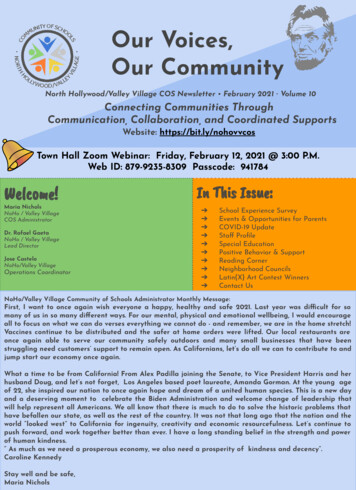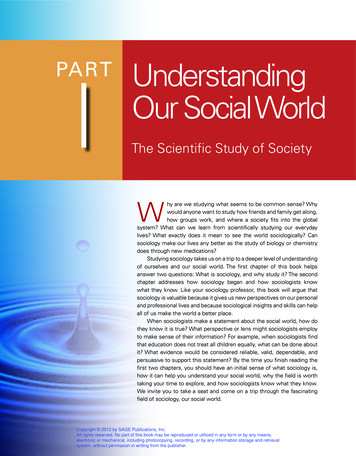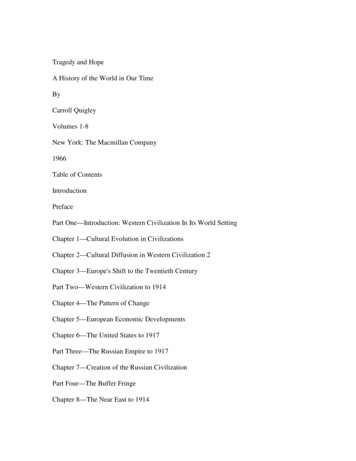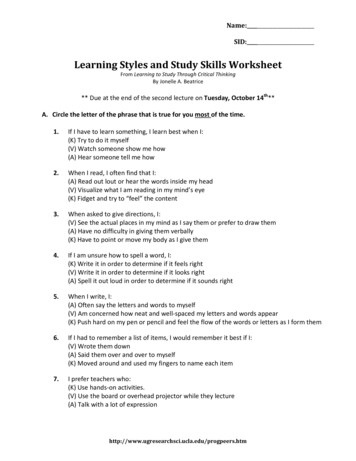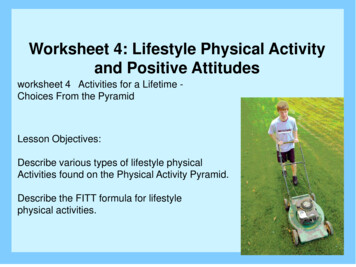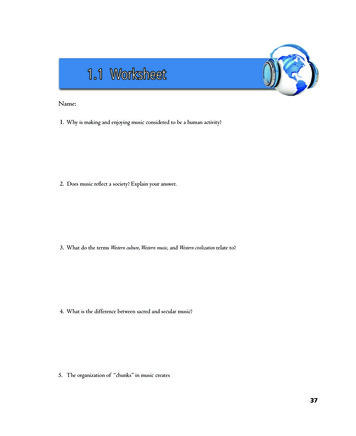
Transcription
1.1 WorksheetName:1. Why is making and enjoying music considered to be a human activity?2. Does music reflect a society? Explain your answer.3. What do the terms Western culture, Western music, and Western civilization relate to?4. What is the difference between sacred and secular music?5. The organization of “chunks” in music creates.37ch01.indd 378/8/16 6:16 PM
381.1 Worksheet6. Pitch is the highness or lowness of music. What is an octave?7. Define these terms:staffclef signledger lines8. Explain how a sharp or flat note is created.9. What is rhythm, and how does it relate to music, as well as life?ch01.indd 388/8/16 6:16 PM
1.2 WorksheetName:List the duration names of notes and rests, and draw their symbols.NotesRests1.1.2.2.3.3.4.4.Match the musical term and the definition.1. notationA. An Italian word that means “speed” in music2. dynamicsB. When notes and rhythms are put together in a sequential manner3. timbreC. A system used to write music4. harmonyD. How a sound is played or sung5. melodyE. The gathering of beats into regular groups6. tempoF. The tonal quality of sound7. articulationG. Sounds occurring simultaneously with the melody8. meterH. VolumeDynamics (loudness) is often notated using Italian terms. Match these terms:1. fortississimovery, very soft2. pianississimovery loud3. fortemedium soft4. pianomedium loud5. fortissimoloud6. pianissimosoft7. mezzo fortevery soft8. mezzo pianovery, very loud39ch01.indd 398/8/16 6:16 PM
401.2 WorksheetThe “thickness” of music is called texture. List the four textures of music and explain each.1.2.3.4.ch01.indd 408/8/16 6:16 PM
1.3 WorksheetName:1. Of these three textures of music, which is the most complex? (circle one)MonophonicHomophonicPolyphonic2. The performance of music can include voices, instruments, or combinations of both. List the three ranges of maleand female voices.Male VoicesFemale VoicesHighestHighestMiddleMiddleLowestLowest3. If a sound is under human control but is not created with the human voice, it is considered to be an instrumentalsound. Describe these types of dophones41ch01.indd 418/8/16 6:16 PM
421.3 Worksheet4. Name the five categories of Western acoustic instruments.5. There are two types of percussion instruments. Give examples of each.definite pitchindefinite pitch6. Some of the first keyboard instruments were theand the, the,.7. In the early eighteenth century, they were replaced by the, or the,as we call it today.8. What are the differences between a piano and an organ?ch01.indd 428/8/16 6:16 PM
1.4 WorksheetName:1. The two classifications of aerophones areand.2. What is the difference between a closed-ended and an open-ended woodwind instrument? Give examples of each.3. What are the two types of closed-ended instruments?4. How does a reed instrument produce sound?5. When were valves added to brass instruments?6. How is the playing of a brass instrument different from the playing of a woodwind instrument?43ch01.indd 438/8/16 6:16 PM
441.4 Worksheet7. Name the five most common Western brass instruments.8. In Western music, chordophones are called stringed instruments. How do these instruments produce sound?9. What are f-holes?10. What determines the pitch of a modern stringed instrument?11. Name five common modern acoustic stringed instruments.12. How does a guitarron differ from a guitar or a dulcimer?ch01.indd 448/8/16 6:16 PM
1.5 WorksheetName:1. In the early twentieth century, electricity became part of our world. As it advanced, so did musical instrument design. What are the two types of instruments using electricity?2. What is a pickup, and how does it work?3. Which features are shared with an electric bass, a double bass, a guitarron, and an electric guitar?4. Explain how a synthesizer works.45ch01.indd 458/8/16 6:16 PM
461.5 Worksheet5. What is the difference between analog and digital?6. What does the acronym MIDI represent and how was it used in making music ?7. What is sampling?8. Do you think that music in our world will continue to change? Why or why not?ch01.indd 468/8/16 6:16 PM
1.6 WorksheetName:Listen to a piece of music (any piece of your choice, from the textbook or not) and complete the following.1. Name of the piece of music:2. Name of the composer:3. List of instruments used:4. What is the musical texture of this work?47ch01.indd 478/8/16 6:16 PM
481.6 Worksheet5. Discuss the dynamics.6. Discuss the tempo.7. Describe your mood or moods while listening to this piece of music.ch01.indd 488/8/16 6:16 PM
1.7 WorksheetName:Define the following terms:1. Western music2. Pythagoras3. form4. pitch5. hertz6. octave7. scales8. staff9. clef sign10. ledger lines11. sharp12. flat13. rhythm14. notation49ch01.indd 498/8/16 6:16 PM
501.7 Worksheet15. melody16. meter17. dynamics18. articulation19. whole note20. half note21. quarter note22. eighth note23. whole rest24. half rest25. quarter rest26. eighth rest27. legato28. staccato29. accent30. fermata31. timbre32. tempoch01.indd 508/8/16 6:16 PM
1.8 WorksheetName:Define the following terms:1. complexity2. texture3. monophonic4. heterophonic5. homophonic6. polyphonic7. range8. tenor9. bass10. baritone11. soprano12. alto13. mezzo-soprano14. acoustic51ch01.indd 518/8/16 6:16 PM
521.8 Worksheet15. idiophones16. membranophones17. aerophones18. chordophones19. percussion instruments20. keyboard instruments21. woodwind instruments22. brass instruments23. stringed instruments24. electrical instruments25. electronic instruments26. synthesizer27. theremin28. MIDI29. sequencers30. samplingch01.indd 528/8/16 6:16 PM
1.9 WorksheetName:Locate the following musical elements and place the corresponding number in the space provided.1. Whole rest6. Dynamic indication11. Whole note2. Half rest7. Tempo indication12. Eighth notes3. Quarter rest8. Sharp13. Bass clef4. Eighth rest9. Half note14. Treble clef5. Instrument names10. Quarter note15. Flat53ch01.indd 538/8/16 6:16 PM
541.9 WorksheetLocate the following musical elements and place the corresponding number in the space provided.1. Whole rest6. Dynamic indication11. Whole notech01.indd 542. Half rest7. Tempo indication12. Eighth notes3. Quarter rest8. Sharp13. Bass clef4. Eighth rest9. Half note14. Treble clef5. Instrument names10. Quarter note15. Flat8/8/16 6:16 PM
22. eighth note 23. whole rest 24. half rest 25. quarter rest 26. eighth rest 27. legato 28. staccato 29. accent 30. fermata 31. timbre 32. tempo 50 1.7 Worksheet ch01.indd 50 8/8/16 6:16 PM. Name: 1.8 Worksheet 51 Define the following terms: 1.complexity 2. texture 3. monophonic 4. heterophonic 5. homophonic 6. polyphonic 7. range 8. tenor 9. bass 10. baritone 11. soprano 12. alto 13. mezzo .

